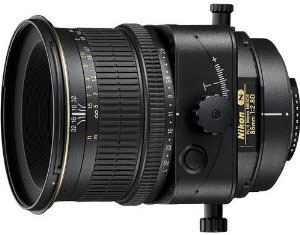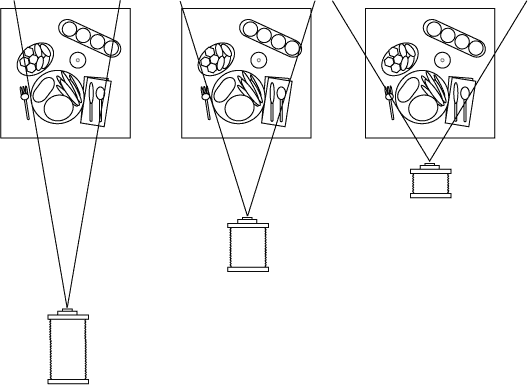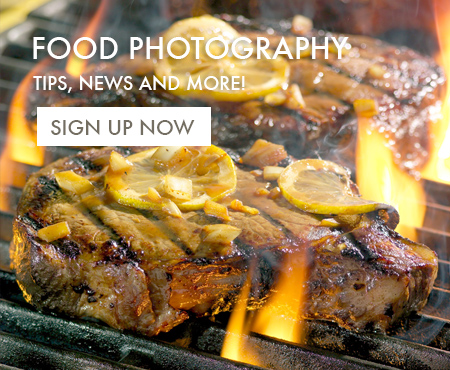What’s the best camera lens for digital food photography?
“What is the best lens for food Photography?” was a post that I recently came across in a popular photography forum. After reading the various replies, I started to realize that most novice photographers are under the impression that there is a “best lens” for photographing particular subject matters. From my experience as being a professional photographer, I thought I’d add my $.02 to the discussion.
Best lens selection for food photography
Just as in other types of photography, in food photography, one photographer may have his or her “favorite” lens for shooting food, but that doesn’t mean it’s the “best” lens. It may just be the lens that photographer started out using, and over time, that photographer became comfortable with its look. That photographer may conclude that the camera lens she uses is the best lens for photographing food, when in fact, she’s stuck in a rut and wouldn’t even think of using another camera lens, just because of her habit.
The truth is that there is no best lens for photographing food, just like there is no best lens for shooting any other type of photography. Some may disagree with this statement. They may be under the impression, from their visits to various photography forums and from reading various books on the subject, that there are “perfect” lenses for subjects like portraiture or aerial photography. Show me someone that says that there is a perfect lens for a particular subject and I’ll show you a photographer in a rut AND a photographer with no imagination.
Different strokes…
Yes, there may have been times when using that favorite lens has been quite successful. That lens may even have been part of establishing that photographer’s style, just as other photographers use their favorites lenses to create their particular look. One photographer may just like the “look” of that lens and the other just prefers the look or their favorite lens, and at some point, each gravitate to selecting their favorite lens, just out of habit.
If the photographer knows what they are doing, they will select a lens because of a combination of factors that pertain the reason for the photograph and to the individual needs of a particular subject matter. (pretty fancy explanation, :o) One type of shot or a particular type of food my lend itself to using one lens over another. For example, shooting editorial magazine food photography is very different than shooting for food packaging. The differences in the two looks may require the selection of different lenses. This is just one example of why one lens may be better for another.
There are many reasons that a knowledgeable photographer chooses a particular lens. Some of these reasons may include:
- Perspective
- Weight
- Maximum aperture
- Minimum aperture
- Focus flexibility
- Relative sharpness
- Working distance from subject
Lets discuss some of these reasons why a food photographer may select a particular lens as the their “favorite” lens for food photography.
Perspective in food photography
Some photographers believe that distance from the subject is the only thing that changes when they select one lens over another. The truth is that many things change when one lens is selected over the other. The biggest thing that changes is what I call perspective. A wider lens will create a very different effect that a longer (more telephoto) lens. Take a look that the illustrations above. The intended “crop” of each subject photo is the outside of the plate on left side and on the right side, the outside of the spoon. That’s the constant. Notice how much more background is included when using a wide-angle lens. This means that more props would be required to complete the background composition. When using a telephoto lens, fewer props would be required to give a similar compositional feel to the same picture taken with a normal lens.
Another thing that perspective effects is the relative size increase of a closer object, when compared to an another object that is farther away. With a wide-angle lens, closer objects are emphasized and farther away objects are de-emphasized. This effect is a tool to be used by the creative photographer. If you want to emphasize one object in the shot, then maybe a wide angle lens would be a useful tool to use. On the other extreme, maybe the job requires that you give more equal emphasis to multiple objects. For example, maybe you’re shooting this for a grocery store and they want to sell the ingredients in the front dish and the side dish equally. In that case, maybe a telephoto would be a more logical and useful tool. You get the idea.
There are other subtle things that will be going on here too and you really have to look to see what they are. On thing I noticed is when you use a longer lens,from a low position, you almost always see the bottom of the front dish (where it touches the surface). But is if you use a shorter lens, you tend to “stretch out” the bottom of the image and you can usually get away from seeing the bottom of the plate.
Depth-of-field
Another characteristic of a telephoto lens over a wide-angle lens, is that the focus tends to “fall-off” more quickly. The effect helps to concentrate more attention on the main subject of the photo. Again, this is a tool to use in your creativity. There may be times when more focus is desired. If that’s the case, then maybe a normal or wide-angel lens would be a better choice. Camera lenses are tools of creativity. Use the right tool for the job at hand.
Working distance, in digital food photography
When shooting food, working distance between the camera and the plate is something to consider. A food stylist will sometimes have problems working on a plate when the camera and the subject are too close together. He or she may not be able to view that plate from the same angle as the camera, making their job quite difficult. This doesn’t mean that wide lenses should never be used in digital food photography, I’m just saying that it should be taken into account.
Focus control in food photography
Since we’re talking about camera lenses and not cameras, I’ll not go into my sales pitch regarding the advantages of view cameras over DSLR cameras. Most of the people reading this aren’t in a position to get into buying a view camera, but in my opinion, That’s the way to go. This is an arguable issue, because many very successful food photographers use 35mm digital cameras. I’m just not one of them yet. I have been shooting food more and more with my Nikon, but when push comes to shove, I prefer the view camers.
I would like to talk for a moment about view camera lenses. Probably my favorite camera lens for food photography is the 120mm Schneider Super Angulon lens. I like this lens because it’s designed as a wide-angle lens for an 8×10 film camera. Since I shoot with a digital back, and not 8×10 film (who could find it?), I rarely use the large coverage area that this lens offers, but on occasion, I will make some pretty extreme swings or tilts and I’m glad for that coverage. Regular view camera lens are usually okay, but it’s nice to have that extra buffer of a wide-angle design to cover my butt when I try to twist that camera into a pretzel.
Here’s a sample of how a view camera can control focus. Instead of the focus example above where the focus plane is fixed, the view camera can manipulate the focus so that areas can be selected for being in or out of focus.
Most people think that digital photographers only use the view camera’s movements to get things into focus, where in reality, sometimes keeping things “out” of focus can be just as important as a creative tool.
The focus can be manipulated on both the vertical and the horizontal axis.
Camera lens sharpness at a given magnification, in food photography
Another thing to consider when choosing a lens, is its degree of sharpness at a given magnification. Camera lenses are designed for a given magnification range and may not allow you to focus as close as you sometimes may need. That’s why there are such things as Macro lenses. Non-macro lenses are not as sharp doing close-ups. That’s a simple fact. Some lenses are “okay” doing close-ups but many are not sharp at all. The only way to really tell just how sharp your camera lenses are at a given magnification, is to test them.

This is my favorite DSLR food photography lens. It’s a, 85mm macro, with tilt shift capability. It’s pretty much the perfect lens, but that doesn’t mean I wouldn’t want to have other choices, just in case I wanted or needed a different perspective. Having this lens is like turning your DSLR into a view camera.
Lens sharpness at a given f-stop
Sharpness at a given aperture is another factor to consider when selecting a lens. For example, I have a camera lens that is designed as a close-up lens. Through experience, I’ve learned that this particular camera lens is not at all sharp when stopped way down. At f-16, some things are sharp, at f-64, nothing’s sharp. Your lens may be like this too. You’ll have to test your camera lens to know for sure. This applies to view cameras more than it does to DSLR lenses
The importance of relative sharpness of lenses
I’d like to talk for a moment about sharpness. In my opinion, camera lens sharpness is both a relative thing and an over-emphasized issue. I say that sharpness is relative because it has much to do with viewing size. Sometimes images are reproduced so small that the sharpness is irrelevant. (relatively speaking), For example, I used to have a client that pergered to shoot in Chicago because a particular photographer still shot on 8×10 film, and they want the very best. The problem with that was, the client was shooting for a can label! The image would end up being about 2” x 3”! And they insist on shooting 8×10. Boy, those big “chromes” look good. And after they get the film back and reduced it down to 2×3, they are going to scan the film and print the label on a web press. To me, that’s funny!
So to conclude… I can definitely say that I do have favorite lenses but I can honestly say that there is no such thing as a best lens. If you’re a novice, you’ll probably need a macro lens, and something in either the 50mm or a 100mm range will do fine. If you’re a professional though, you should probably have both. I client may NEED a different perspective that the lens you have, and then you won’t be able to give them what they need.
And then there are the times when you don’t need a macro lens, which will be pretty often. In that case you should have a wide range of lenses, from wide to telephoto.
What do you people think of this? Do you agree? Does that help you understand food photography lenses? Please leave a comment and let me know what you think! And if you haven’t already signed up for my email list (below), please do! And if you want to check out that 85mm Nikon macro Tilt / Shift Lens, here’s an Amazon Affiliate Link to take you there.







Great 2 cents. Hadn’t thought of using the the view camera lens for the larger coverage area when doing cirque du soleil bellows movements. Thanks for sharing your wisdom.
Michael,
It is about time you you published a food photography book
Regards
Tim
You don’t need a book, you have the blog! :o)
Just found your blog today and am enjoying reading the entries. This article was great because I was thinking the Canon 90mm TS lens would be a great addition for food photography. I already use the 24TS quite extensively in my typical photography work. Thanks for the enlightenment!